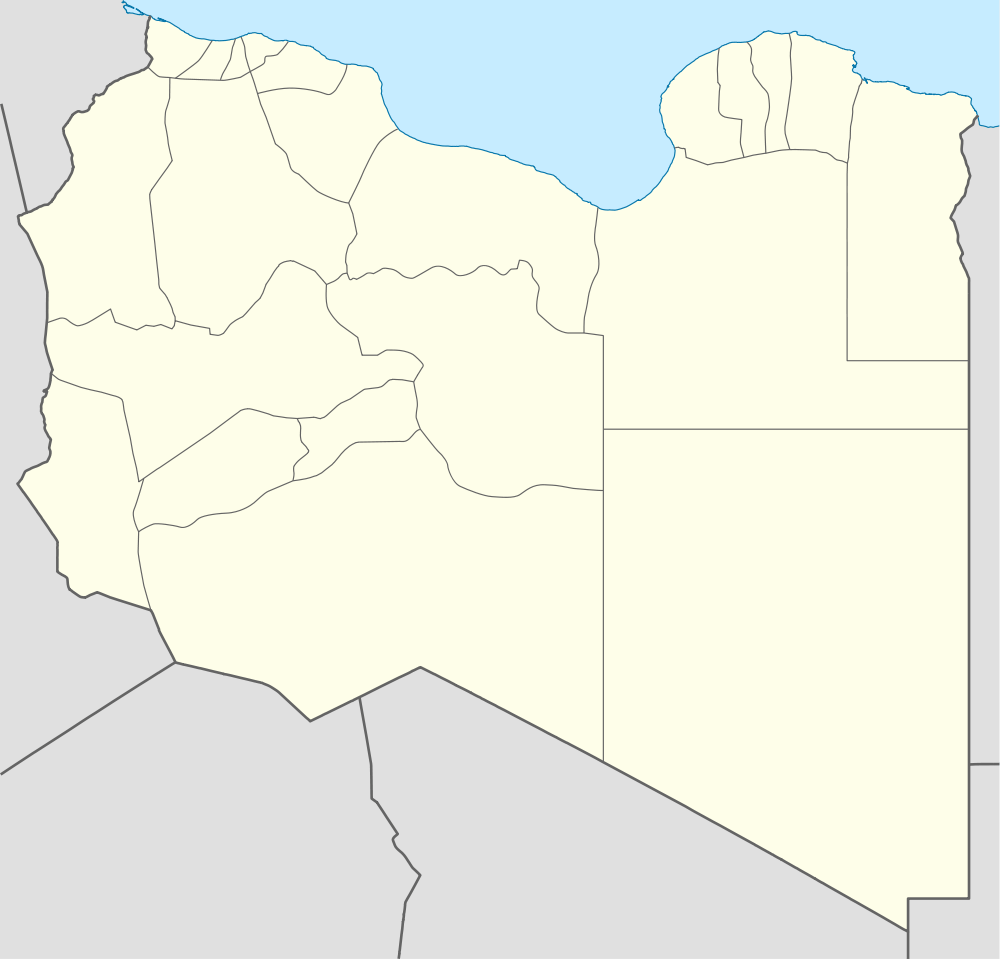Gharyan
| Gharyan غريان Gharian, Garyan | |
|---|---|
| Town | |
 Gharyan Location in Libya | |
| Coordinates: 32°10′11″N 13°01′00″E / 32.16972°N 13.01667°ECoordinates: 32°10′11″N 13°01′00″E / 32.16972°N 13.01667°E | |
| Country |
|
| Region | Tripolitania |
| District | Jabal al Gharbi |
| Elevation[1] | 700 m (2,300 ft) |
| Population (2011)[2] | |
| • Total | 187,854 |
| Time zone | UTC + 2 |
Gharyan (Arabic: غريان) is a town in northwestern Libya, in Jabal al Gharbi District. Prior to 2007 it was the administrative seat of Gharyan District. Gharyan is one of the largest towns in the Nafusa Mountains, an area populated primarily by Berbers.
History

Gharyan was on the trade routes both south to Fezzan and over the Nafusa Mountains. By 1884 the Ottomans had established a mayor and town council in Gharyan.[3]
It was considered the center of Libyan resistance against the Italian invasion in the early 20th century.
2011 Libyan civil war
In 2011 the town became involved in the nationwide anti-Gaddafi uprising. Initially successful, as of 2 March government forces retook it.[4]
In April rebels succeeded in occupying several nearby towns and establishing a second territory in Western Libya besides Misrata that is no longer under the control of the Gaddafi forces, but as of late June the rebels had still failed to take Gharyan.[5] On 13 August 2011, the rebel forces in Libya initiated a new battle for control of the city and were in control within two days.[6]
Lady of Gharyan
Just west of Gharyan, there is a primitive road to the right, which provides a bumpy trip to a derelict former Italian barracks, a relic of World War II.
There is a crumbling building at the camp. Painted on the bricks of one of the walls inside the building is an enormous (c.4m by 10m) representation of a naked woman, lying on her side, American pin-up style.[7] The upper torso of the woman is shaped as an inaccurate representation of the North Africa coast, and the salient points of her anatomy are marked with names of North African towns.
The "Lady of Garian" was drawn by Clifford Saber,[8] a volunteer American ambulance driver with the British 8th Army. Saber created the mural to help boost the morale of his fellow servicemen, finishing on 2 March 1943, while his unit was housed for a few days at the barracks in Gharyan.
Transport
In the 1920s the Italians built a 90 kilometres (56 mi) long railway between Tripoli and a village near Gharyan that was destroyed by the British during World War II.[9]
Economy
Grain and figs are grown for local consumption, with olives and saffron[3] for both local use and export. Gharyan is also well known for its ceramics industry.
See also
Notes
- ↑ "Wolfram Alpha". Retrieved 12 October 2011.
- ↑ World Gazetteer. "Libya: largest cities and towns and statistics of their population". Retrieved 15 October 2011.
- ↑ 3.0 3.1 Anderson, Lisa (1984). "Nineteenth-Century Reform in Ottoman Libya". International Journal of Middle East Studies (16(3)): 325–348, 331.
- ↑ "Battle rages over Libyan oil port". Al Jazeera. 3 March 2011. Retrieved 16 October 2011.
- ↑ Kirkpatrick, David D. (25 June 2011). "Western Libya Earns a Taste of Freedom as Rebels Loosen Qaddafi’s Grip". The New York Times (Rogeban, Libya). Retrieved 16 October 2011.
- ↑ "Libya rebels take Garyan, south of Tripoli-witness". Reuters Africa. Reuters. 18 August 2011. Retrieved 16 October 2011.
- ↑ (picture)
- ↑ Clifford Saber's history and portfolio is at "Sketchbook of a Desert Rat", American Field Service
- ↑ Le ferrovie nell'Africa italiana: aspetti economici, sociali e strategici (in Italian)
External links
![]() Media related to Gharyan at Wikimedia Commons
Media related to Gharyan at Wikimedia Commons
| ||||||||||||
| ||||||